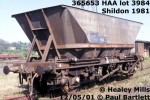| << Profile 7 >> |
HAA 'Merry-go-round' Coal Hoppers |
  
  
| Build Details: |
1964-1977 BR Darlington, Shildon & Ashford |
| Numbering: |
350000-359571, 365000-366129, 368000-368459 |
| Bogies / Suspension: |
Single link |
| Dimensions: |
9041mm LOB, 5561mm Wheelbase |
| Published Drawings: |
BRW |
| Areas of operation: |
South Wales, East Midlands & Yorkshire, North East and Scotland |
| Main liveries: |
Unpainted bodywork, frames in brown, then red, then yellow, then maroon. |
| Summary: |
The HAA wagon (and its derivatives) was part of a drive to improve the efficiency of the movement of coal to power stations. They became the most numerous air-braked wagon type, and quietly went about their business until they were eventually displaced by the closure of many collieries and the introduction of new wagon designs. Although large quantites were scrapped, many lived on, having been rebuilt as box wagons for carrying ballast. |
|
| History: |
NB: This is a brief profile. It will eventually be upgraded to the standard of later profiles, with more detailed information.
The largest fleet of air-braked wagons built for BR comprised over 11,000 32-ton Coal Hoppers introduced under the 'Merry-go-round' concept. The basis of this was that the wagons could operate in a non-stop loop from collieries to power stations, both loading and unloading being undertaken while travelling at low speed. The track layout at the terminals was designed so that the operations could be performed without stopping or shunting.
Two prototype wagons were built at Darlington works in 1964, following which several large batches were constructed at the nearby Shildon works. Ashford also built one small batch of 160 wagons in 1965. Most of the early wagons (up to 355396) were originally lettered with B prefix numbers but these were later removed.
Operation was in block trains of up to 35 wagons, hauled generally by class 47 diesels fitted with the neccessary slow-speed controls. The class 56 diesels were designed with these services in mind and took over most services from 1976 onwards, later being joined by class 58s and 60s. The only time the wagons would be seen in other trains or singly was when they were in transit for repairs.
While the majority of the wagons were built as HAAs, the final batch (built in 1982 as 368000-368459) were coded as HDA to indicate their ability to operate at up to 60mph when empty instead of the standard 45mph. This was achieved through modifcations to the design of the brakes. Another variation, which did not initially result in a change of TOPS code, was the fitting of top canopies to increase the load volume. Many of the early wagons had these but then lost them and for some years canopied hoppers were only common in Scotland.
From the early 1990s further TOPS codes were introduced to show detail differences such as canopies and modified brakes. Many HAAs became HFAs, while all of the HDAs became HBAs, this code now being available since all the original HBA hoppers had been rebuilt as HEAs. Later codes used were HCA, HMA and HNA. 15 HAAs were rebuilt as china clay hoppers with a canvas roof (CDA), all but one of which were renumbered in the 375124-375137 range.
The livery of these wagons was of unpainted metal hoppers and black underframes. The hopper support framework was originally brown, then red with the introduction of the new Railfreight image in the late 1970s. When Railfreight re-invented itself in 1987, a new livery with yellow framework and a large coal sector logo on the hopper side was introduced. Under EWS the framework is now painted maroon. Merry-go-round hoppers were worked hard however, and the typical livery included a coating of coal dust. Some of the terminals served used stationery shunters to move the wagons forward at low speed. These often featured tyred wheels that gripped the wagon sides, resulting in horizontal streaks on the hopper sides.
The decline in the UK mining industry from the 1980s onwards made many of these wagons redundant. More of the type were replaced when EWS introduced a new batch of 1144 high-capacity bogie coal hoppers (HTA) from 2001. Although many HAAs were scrapped as being worn out, over 1000 have donated their underframes to be rebuilt as MHA low-sided box spoil wagons for infrastructure and general use. Conversions have been undertaken since 1997 and the new vehicles have been numbered in the 394001-394999 and 396000-396101 ranges. At least 10 other HAAs were modified as MSA Scrap Hoppers in 2004 and renumbered in the 397000-397013 range. |
|
| Queries: |
|
|
| References: |
|
|
| Links: |
Photos of HAA wagons pre-1980 on Paul Bartlett's website
Photos of HDA wagons on Paul Bartlett's website
Photos of HAA wagons and variants from 1980 onwards on Paul Bartlett's website
Photos of HAA wagons with top canopies on Paul Bartlett's website
Photos of HAA wagons on Martyn Read's website
Photos of HBA wagons on Martyn Read's website
Photos of HCA wagons on Martyn Read's website
Photos of HDA wagons on Martyn Read's website
Photos of HFA wagons on Martyn Read's website
Photos of HMA wagons on Martyn Read's website
Photos of HNA wagons on Martyn Read's website
Photos of HAA wagons on Andy Jupe's website
Photos of HBA wagons on Andy Jupe's website
Photos of HCA wagons on Andy Jupe's website
Photos of HDA wagons on Andy Jupe's website
Photos of HFA wagons on Andy Jupe's website
Photos of HMA wagons on Andy Jupe's website
Photos of HNA wagons on Andy Jupe's website
|
|
| Updates: |
15/03/2013: Photo links (finally) updated. |
|
| Photos |
| For more pictures see the Links section at the bottom |

HAA 365653 at Healey Mills 12th May 2001.
Paul Bartlett
|
|






